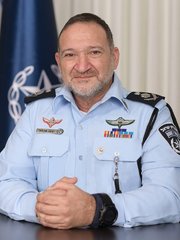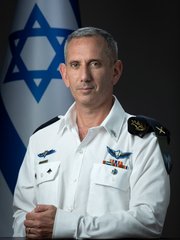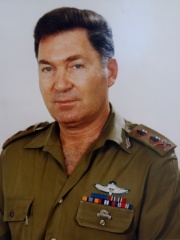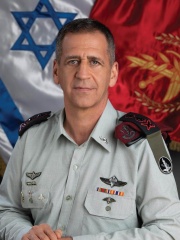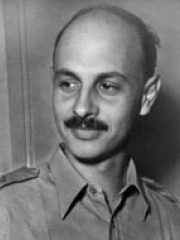
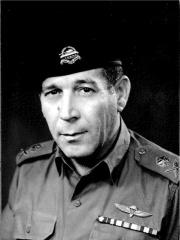
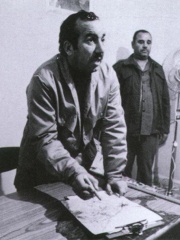
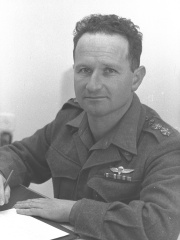
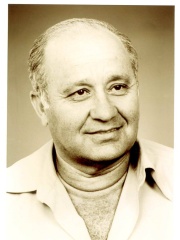
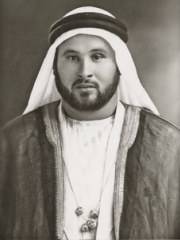
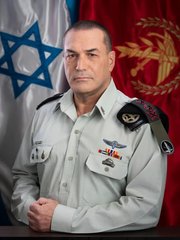
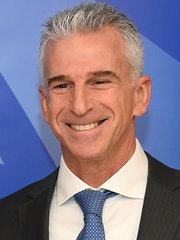
The Most Famous
MILITARY PERSONNELS from Israel
This page contains a list of the greatest Israeli Military Personnels. The pantheon dataset contains 2,058 Military Personnels, 17 of which were born in Israel. This makes Israel the birth place of the 18th most number of Military Personnels behind Iran, and Croatia.
Top 10
The following people are considered by Pantheon to be the top 10 most legendary Israeli Military Personnels of all time. This list of famous Israeli Military Personnels is sorted by HPI (Historical Popularity Index), a metric that aggregates information on a biography's online popularity. Visit the rankings page to view the entire list of Israeli Military Personnels.

1. Yigael Yadin (1917 - 1984)
With an HPI of 65.13, Yigael Yadin is the most famous Israeli Military Personnel. His biography has been translated into 31 different languages on wikipedia.
Yigael Yadin (Hebrew: יִגָּאֵל יָדִין [jigaˈel jaˈdin]; 20 March 1917 – 28 June 1984) was an Israeli archeologist, soldier and politician. He was the second Chief of Staff of the Israel Defense Forces and Deputy Prime Minister from 1977 to 1981.

2. Israel Tal (1924 - 2010)
With an HPI of 64.58, Israel Tal is the 2nd most famous Israeli Military Personnel. His biography has been translated into 24 different languages.
Israel Tal (Hebrew: ישראל טל; 13 September 1924 – 8 September 2010), also known as Talik (Hebrew: טליק), was an Israel Defense Forces (IDF) general known for his knowledge of tank warfare and for leading the development of Israel's Merkava tank.

3. Khalil al-Wazir (1935 - 1988)
With an HPI of 62.63, Khalil al-Wazir is the 3rd most famous Israeli Military Personnel. Her biography has been translated into 20 different languages.
Khalil Ibrahim al-Wazir (Arabic: خليل إبراهيم الوزير, also known by his kunya Abu Jihad أبو جهاد—"Jihad's Father"; 10 October 1935 – 16 April 1988) was a Palestinian leader and co-founder of the nationalist party Fatah. As a top aide of Palestine Liberation Organization (PLO) Chairman Yasser Arafat, al-Wazir had considerable influence in Fatah's military activities, eventually becoming the commander of Fatah's armed wing al-Assifa. Al-Wazir became a refugee when his family was expelled from Ramla during the 1948 Arab–Israeli War, and began leading a minor fedayeen force in the Gaza Strip. In the early 1960s he established connections for Fatah with Communist regimes and prominent third-world leaders. He opened Fatah's first bureau in Algeria. He played an important role in the 1970–71 Black September clashes in Jordan, by supplying besieged Palestinian fighters with weapons and aid. Following the PLO's defeat by the Jordanian Army, al-Wazir joined the PLO in Lebanon. Prior to and during Israel's 1982 invasion of Lebanon, al-Wazir planned numerous attacks inside Israel against both civilian and military targets. He prepared Beirut's defense against incoming Israeli forces. Nonetheless, the Israeli military prevailed and al-Wazir was exiled from Lebanon with the rest of the Fatah leadership. He settled in Amman for a two-year period and was then exiled to Tunis in 1986. From his base there, he started to organize youth committees in the Palestinian territories; these eventually formed a major component of the Palestinian forces in the First Intifada. However, he did not live to command the uprising. On 16 April 1988, he was assassinated at his home in Tunis by Israeli commandos.

4. Uzi Narkiss (1925 - 1997)
With an HPI of 61.58, Uzi Narkiss is the 4th most famous Israeli Military Personnel. His biography has been translated into 21 different languages.
Uzi Narkiss (Hebrew: עוזי נרקיס; January 6, 1925 – December 17, 1997) was an Israeli general. Narkiss was commander of the Israel Defense Forces (IDF) units in the Central Region during the 1967 Six-Day War. Narkiss appears in the famous photograph of Defense Minister Moshe Dayan flanked by Chief of Staff Yitzhak Rabin taken in the Old City of Jerusalem shortly after its capture from Jordanian forces.
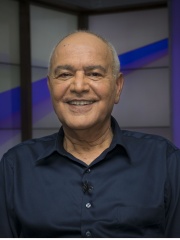
5. Dan Halutz (b. 1948)
With an HPI of 61.41, Dan Halutz is the 5th most famous Israeli Military Personnel. His biography has been translated into 23 different languages.
Dan Halutz (Hebrew: דן חלוץ, ; born August 7, 1948) is an Israeli Air Force lieutenant general, former Chief of Staff of the Israel Defense Forces, Commander of the Israeli Air Force and former chairman of the Israeli Basketball Association. Halutz served as chief of staff in 2005–2007 and as chairman of the Israeli Basketball Association in 2013-2014.

6. Yitzhak Hofi (1927 - 2014)
With an HPI of 61.17, Yitzhak Hofi is the 6th most famous Israeli Military Personnel. His biography has been translated into 16 different languages.
Yitzhak Hofi (Hebrew: יצחק חופי; 25 January 1927 – 15 September 2014) was a member of the Palmach, IDF General, chief of the Northern Command (Israel), and director of the Mossad.

7. Hasan Salama (1912 - 1948)
With an HPI of 60.67, Hasan Salama is the 7th most famous Israeli Military Personnel. His biography has been translated into 15 different languages.
Hasan Salama (also spelled Hassan Salameh; Arabic: حسن سلامة, Ḥasan Salāmah; 1913 – 2 June 1948) was a Palestinian Arab nationalist guerrilla leader and commander who led the Palestinian Holy War Army (Jaysh al-Jihad al-Muqaddas, Arabic: جيش الجهاد المقدس) in the 1948 Palestine War along with Abdul Qadir al-Husseini.

8. Eyal Zamir (b. 1966)
With an HPI of 60.48, Eyal Zamir is the 8th most famous Israeli Military Personnel. His biography has been translated into 19 different languages.
Eyal Zamir (Hebrew: אייל זמיר; born 26 January 1966) is an Israeli military officer who is the current Chief of the General Staff of the Israel Defense Forces, having taken office on 5 March 2025. Zamir previously served as the Director-General of the Israeli Ministry of Defense (2023–2025), as Deputy Chief of Staff between 2018 and 2021, commander of the Southern Command, Military Secretary to the Prime Minister, commander of the 36th Division and commander of the 7th Armored Brigade.

9. David Barnea (b. 1965)
With an HPI of 60.13, David Barnea is the 9th most famous Israeli Military Personnel. His biography has been translated into 20 different languages.
David "Dadi" Barnea (Hebrew: דוד (דדי) ברנע; born 29 March 1965) is an Israeli intelligence chief who serves as the current director of the Mossad, having taken over from Yossi Cohen in June 2021.
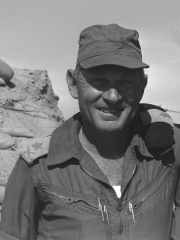
10. Avraham Adan (1926 - 2012)
With an HPI of 59.58, Avraham Adan is the 10th most famous Israeli Military Personnel. His biography has been translated into 16 different languages.
Avraham "Bren" Adan (Hebrew: אברהם "ברן" אדן; (1926-10-05)5 October 1926 – (2012-09-28)28 September 2012) was an Israeli major-general and author. Prior to Israel's independence, he served with the Palmach, an elite formation within the Haganah paramilitary force of the Yishuv community in British Mandatory Palestine. Adan fought under the Haganah and later under the newly formed Israel Defense Forces during the First Arab–Israeli War, and was photographed while raising the Israeli Ink Flag at the site of what is now Eilat to mark the end of the war. He served with the Israel Defense Forces from 1948 to 1977, and fought in all of the major Arab–Israeli wars that occurred during that period.
People
Pantheon has 17 people classified as Israeli military personnels born between 1912 and 1986. Of these 17, 8 (47.06%) of them are still alive today. The most famous living Israeli military personnels include Dan Halutz, Eyal Zamir, and David Barnea. The most famous deceased Israeli military personnels include Yigael Yadin, Israel Tal, and Khalil al-Wazir. As of April 2024, 6 new Israeli military personnels have been added to Pantheon including Eyal Zamir, David Barnea, and Yair Golan.
Living Israeli Military Personnels
Go to all RankingsDan Halutz
1948 - Present
HPI: 61.41
Eyal Zamir
1966 - Present
HPI: 60.48
David Barnea
1965 - Present
HPI: 60.13
Yair Golan
1962 - Present
HPI: 57.09
Gilad Shalit
1986 - Present
HPI: 55.48
Ronen Bar
1965 - Present
HPI: 53.22
Kobi Shabtai
1964 - Present
HPI: 52.69
Daniel Hagari
1976 - Present
HPI: 50.34
Deceased Israeli Military Personnels
Go to all RankingsYigael Yadin
1917 - 1984
HPI: 65.13
Israel Tal
1924 - 2010
HPI: 64.58
Khalil al-Wazir
1935 - 1988
HPI: 62.63
Uzi Narkiss
1925 - 1997
HPI: 61.58
Yitzhak Hofi
1927 - 2014
HPI: 61.17
Hasan Salama
1912 - 1948
HPI: 60.67
Avraham Adan
1926 - 2012
HPI: 59.58
Dan Shomron
1937 - 2008
HPI: 59.11
Aviv Kochavi
1964 - Present
HPI: 53.48
Newly Added Israeli Military Personnels (2025)
Go to all RankingsEyal Zamir
1966 - Present
HPI: 60.48
David Barnea
1965 - Present
HPI: 60.13
Yair Golan
1962 - Present
HPI: 57.09
Ronen Bar
1965 - Present
HPI: 53.22
Kobi Shabtai
1964 - Present
HPI: 52.69
Daniel Hagari
1976 - Present
HPI: 50.34
Overlapping Lives
Which Military Personnels were alive at the same time? This visualization shows the lifespans of the 8 most globally memorable Military Personnels since 1700.




